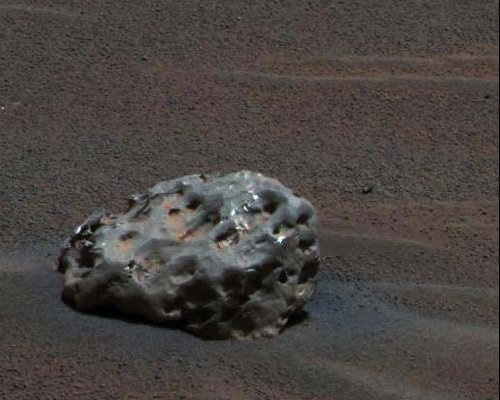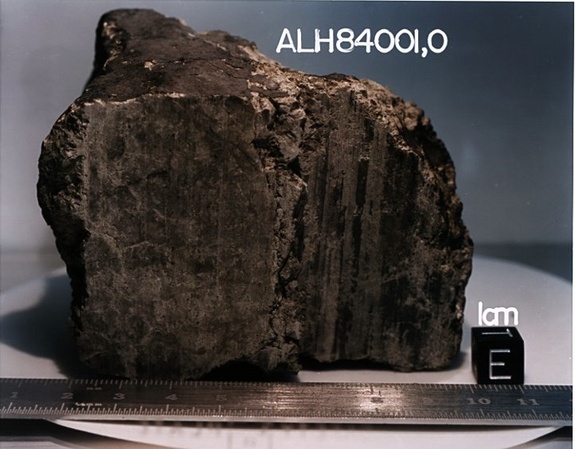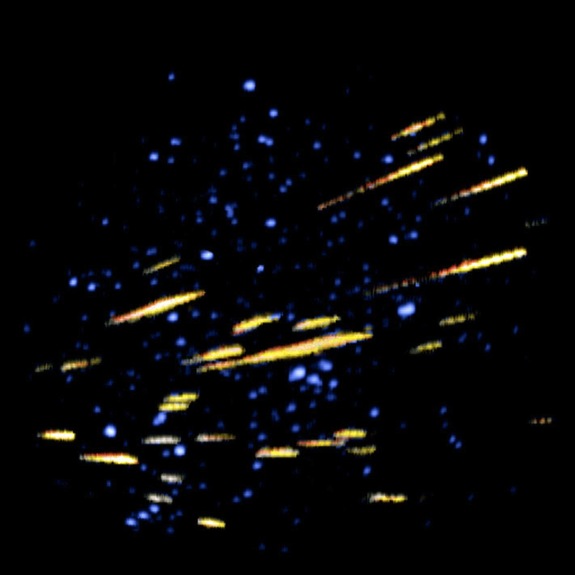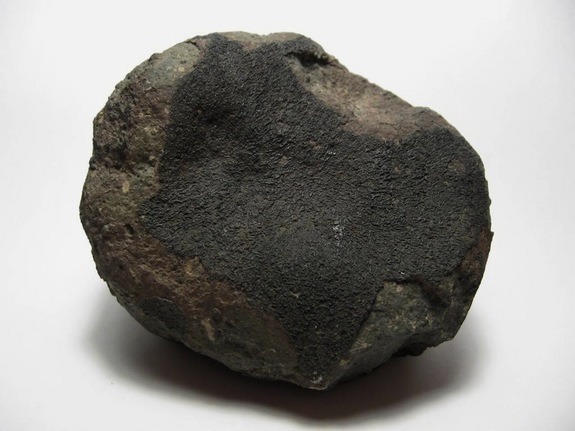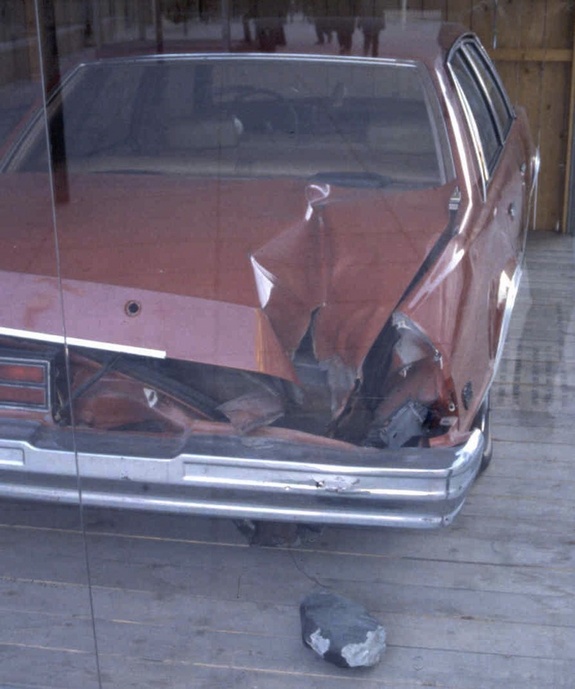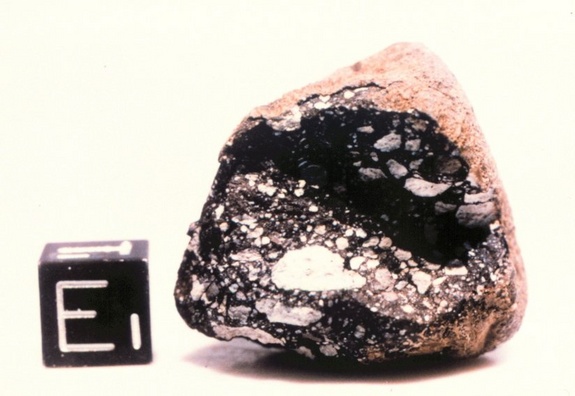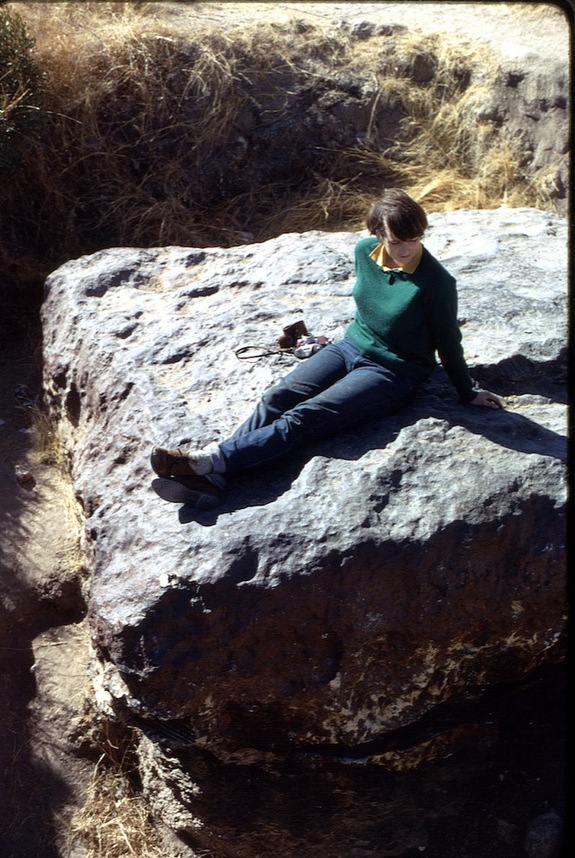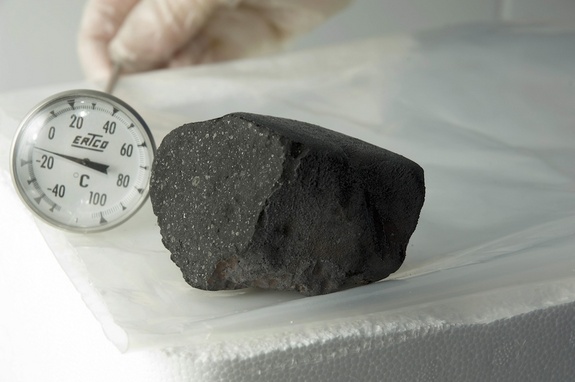While pondering the frightful if awe inspiring meteor explosion over Chelyabinsk, in the Ural Mountains region of Russia, on February 15, Deep Roots got to wondering about a lot of things, notably the fate of the earth should one of these flaming space rocks strike a major city or be considerably larger than this one, which clocked in at 56 feet and 7,000 tons traveling at 40,000 MPH. Apart from that minor rumination, we were curious as to why these things have only struck remote areas of Russia of late, seeing as how the last such meteor visit was in Tunguska in 1908, which annihilated 80 million trees across some 830 square miles of Siberian forest. As we await an answer to that query, our thoughts turned to other famous meteors in history. LiveScience.com senior writer Stephanie Pappas provided some illumination on that point. No answers yet about the fate of the earth, but we’ll keep you posted.
OTHERWORLDLY METEORITE
Earth isn’t the only planet with alien rocks. NASA’s Mars Exploration Rover Opportunity found this iron meteorite on the Red Planet, the first meteorite ever found on another world. The basketball-sized rock, dubbed “heat shield rock” because it sits near the debris of Opportunity’s heat shield, is mostly nickel and iron. (Photo Credit: NASA)
MARTIAN METEORITE
Another controversial chunk of rock, this meteorite from Mars was found in 1984 in the Allan Hills ice field in Antarctica and dubbed ALH84001. In 1996, researchers announced in the journal Science that structures in the meteorite might be fossilized microbial life, setting off the kind of media storm that you’d expect from a story about potential life on Mars. But most scientists remain skeptical that the Allan Hills specimen is evidence of life, and studies since 1996 have been unable to conclusively prove that the original claims are true. (Photo Credit: NASA/Johnson Space Center’s Meteorite Processing Laboratory)
OLD ROCK, NEW MINERAL
Occasionally, meteorites bring something new to Earth. This 4.5-billion-year-old meteorite landed in northwest Africa. Inside, scientists discovered a mineral called krotite, which had never been found in nature before. Krotite forms at high temperatures and low pressure, and was likely one of the first minerals in the newly emerging solar system. (Photo Credit: Chi Ma)
LIFE IN A METEORITE?
The Orgueil meteorite fell in France in 1864 and caused a firestorm in scientific circles in 2011. NASA scientist Richard Hoover claimed in March 2011 in the Journal of Cosmology that filaments in the meteorite, seen under a scanning electron microscope, could be evidence of extraterrestrial bacteria. Other scientists, however, called foul, pointing out that the structures could be created by non-organic processes. (Photo Credit: Hoover/Journal of Cosmology)
STONES FROM THE SKY
Earth gets alien visitors all the time, in the form of space debris that makes it through our atmosphere. The terms can be confusing, so here’s a glossary: Meteoroids are defined by the International Astronomical Union as “a solid object moving in interplanetary space, of a size considerably smaller than an asteroid and considerably larger than an atom.” When a meteoroid enters a planet’s atmosphere, its bright path across the sky is called a meteor. When a meteor makes it through the atmosphere without burning up entirely, the remnants found on earth are called meteorites. Above, a meteor outburst during the Perseid meteor showers of 1995. Friction in the atmosphere turns rocks into fireballs. (Photo Credit: S. Molau and P. Jenniskens, NASA Ames Research Center)
ALLENDE METEORITE
This 3-inch (8 centimeter)-wide meteorite fragment is part of the Allende meteorite, the most-studied meteorite ever. This car-sized chunk of rock flamed through Earth’s atmosphere in February, 1969. It broke into thousands of smaller pieces, found strewn over the desert in the northern Mexico state of Chihuahua. The Allende meteorite is a carbonaceous chondrite, a rare type of meteorite that makes up only about 4 percent of known meteorites. The Allende meteorite contains components that are more than 4.5 billion years old, making the rock a snapshot of the conditions present in the earliest days of the solar system. (Photo Credit: H. Raab, Wikimedia Commons)
CAR CRASH
Not every meteorite falls in a near-empty desert. The Peekskill meteorite crashed into this unlucky car in New York in 1992. The meteorite itself was unremarkable, but more than a dozen people caught its entry into the atmosphere on video, providing scientists with a plethora of data on the meteorite’s behavior before it hit the ground. The car has found fame, too. It’s now owned by R.A. Langheinrich Meteorites, and has been put on display around the world. (Photo Credit: Pierre Thomas, LST, ENS Lyon)
MOON METEORITE
Until the 1980s, scientists believed that all meteorites came from the asteroid belt between Mars and Jupiter. This white-speckled rock changed all that. Researchers found it in Antarctica in 1981 and noticed its similarity to the moon rocks that Apollo astronauts brought back to Earth. Sure enough, tests showed that this rock came from the moon. In the next 15 years, 11 other moon rocks would be found on Earth. (Photo Credit: NASA Johnson Space Center)
WILLAMETTE WONDER
The Willamette meteorite is the largest ever found in North America. A settler named Ellis Hughes found the meteorite in Oregon in 1902 and moved the 15.5-ton iron rock to his own property. It wasn’t the meteorite’s first terrestrial journey: Because no impact crater was found at the meteor’s original resting site, researchers suspect it landed elsewhere and was transported to Oregon via glacial action during the Ice Age. The meteorite is now on display at the American Museum of Natural History in New York City. The deep crevasses of the meteorite resulted from both its high-speed atmospheric entry and subsequent terrestrialization, i.e., weathering. Exposed to the elements for thousands of years, rainwater interacted with the mineral troilite, resulting in a form of sulfuric acid, which slowly dissolved portions of the meteorite. This resulted (over a very long period) in the development of the hollows that are visible today. (Photo Credit: Dante Alighieri, Wikimedia Commons)
BURIED IRON
The Hoba meteorite in Namibia is the largest-known single meteorite piece on Earth. A farmer discovered the gigantic iron mass while plowing his field in the early 1900s. It was soon excavated and estimated to weigh about 66 tons. Because of its huge mass, the meteorite has never been moved. (Photo Credit: Public domain)
TAGISH LAKE
In January 2000, a meteoroid exploded over Tagish Lake in southwestern Canada, scattering the frozen lake with at least 22 pounds (10 kg) of meteorites. A June 2011 study published in the journal Science found significant geological variation among fragments, with some containing amino acids and other biochemical building blocks of life. (Photo Credit: Michael Holly, Creative Services, University of Alberta)
Image album from Live Science.com
Text by Stephanie Pappas, LiveScience Senior Writer


